Koke’e State Park, Kauai, Hawaii
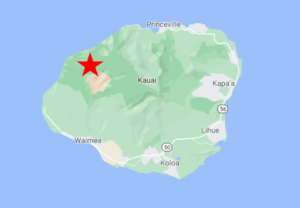
Koke’e State Park is the most accessible site to search for Kauai’s endemic birds: three of which are still reliably seen there: Kauai Elepaio, Anianiau, and Kauai Amakihi. A fourth, the Akeke’e, has become scarce and unpredictable. The other two surviving Kauai endemics—the Puaiohi and Akikiki—are mostly confined to the Alakai Wilderness, a forbiddingly muddy realm of cloud forest and peat bogs to which Koke’e is the gateway. The Koke’e area is also among the more reliable sites for several introduced species, including Erckel’s Francolin, Red Junglefowl, White-rumped Shama, and Chinese Hwamei.
Orientation
Directions
Koke’e State Park is at the end of Highway 550, above Waimea Canyon, about an hour’s drive (40 miles) from Lihue, and 30 minutes (15 miles) from the town of Waimea. Take Highway 50 west to Waimea and turn right onto Waimea Canyon Drive (a.k.a. Highway 550).
An alternative route—not as highly recommended, especially for first-time visitors—is to continue past Waimea on Highway 50 for 3.5 miles into Kekaha, then turn right onto Alae Road. After three blocks Alae Road merges into Kokee Road, which is an alternative route up to Waimea Canyon.
Just above Kekaha, Kokee Road forks right and becomes a little-traveled and occasionally maintained mountain road. After about five miles it joins Highway 550 at the lower end of Waimea Canyon State Park. Kokee Road has less traffic than Highway 550, so it is somewhat more pleasant, but its condition is less reliable.
Attractions
Waimea Canyon, nicknamed “Grand Canyon of the Pacific,” is accordingly scenic and the gateway to Koke’e State Park.
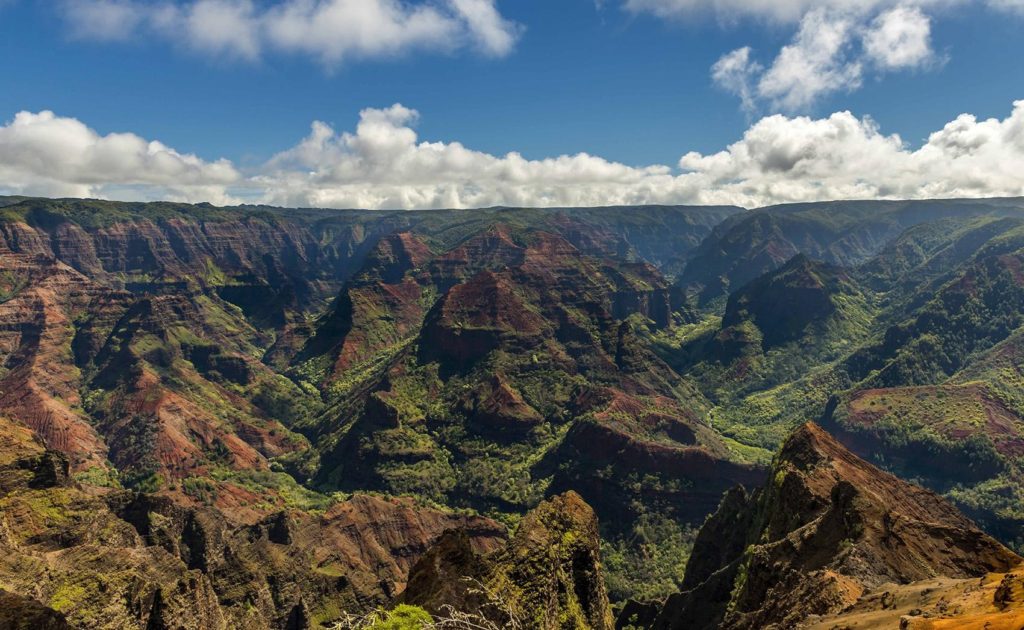
Waimea Canyon, view from Highway 550 en route to Koke’e State Park. © Go Hawaii
Birdfinding
Koke’e State Park has an extensive trail network and many areas available for exploration. Visiting birdwatchers with constrained schedules will generally want to maximize their prospects of finding as many of the six Kauai-only endemics as possible, which predictably sends most of them straight to the Pihea Trail, at the end of the road.
A detailed map of the Koke’e area shows a bewildering network of side-roads, trails, and landmarks, far more options than any traveler can pursue in one trip. Key points along the main road include: park headquarters, Kumuwela Road, the campground, the Awa-awapuhi Trail, the Kaluapuhi Trail, the Kalalau Overlook, and Pu’u O Kilo Overlook.

Male Anianiau at Koke’e State Park. © Jim Denny
Park Headquarters. A spur road on the left leads to the park’s main service area for visitors, which consist of the headquarters, Koke’e Natural History Museum, and Koke’e Lodge. Continuing on the main road just past the headquarters, a junction on the right is the unpaved Kumuwela Road, which arrives at the Halemanu-Koke’e and Kumuwela Trails about 0.5 miles from the main road.
After another 0.3 miles on the main road, you reach another junction. At this point the campground is on your left and on your right is unpaved Camp 10 Road, the primary access route to many of the park’s more interesting trails (see below). Past the campground, Highway 550 continues for another 2.5 miles to its end at the Pu’u O Kilo Overlook.

Male Kauai Amakihi at Koke’e State Park. © Dubi Shapiro
Awa-awapuhi Trail. About a mile past the campground is the trailhead for the Awa-awapuhi Trail, which is a strenuous hike down toward the Na Pali Coast. Highly regarded for its scenic vistas, this trail is often active and often produces the commoner highland endemics—mainly Kauai Amakihi, but sometimes also Kauai Elepaio and Anianiau—as well as several introduced birds, including Erckel’s Francolin.
Kaluapuhi Trail. About 0.2 miles past the Awa-awapuhi Trail is the main trailhead of the Kaluapuhi Trail. The first half of this trail is generally better walking than the second half (where it rejoins the main about a half-mile after the Kalalau Overlook), and affords good prospects for Kauai Elepaio, Kauai Amakihi, and Anianiau, as well as White-rumped Shama, Chinese Hwamei, and more common species.
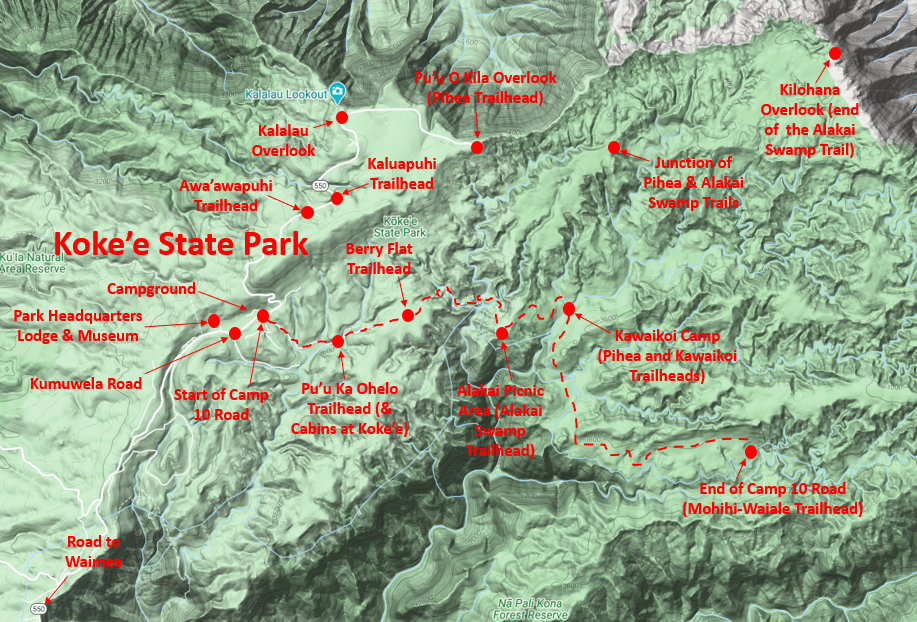
Kalalau Overlook. Every visitor will want to stop to take in the view of Kalalau Valley. The popular overlook is just off the main road on a well-marked spur, about a half-mile past the Kaluapuhi Trail. A stroll around the overlook and parking area can often yield several species of birds, including Kauai Elepaio, Apapane, Kauai Amakihi, sometimes I’iwi and Anianiau, and rarely (or formerly) Akeke’e.
Pu’u O Kilo and the Upper Pihea Trail. The Pihea Trail begins where the pavement ends, at the Pu’u O Kilo Overlook. The overlook itself is a good place to find Kauai Elepaio and Kauai Amakihi, and could produce I’iwi, Anianiau, or Akeke’e, but the odds of these improve by walking the trail.
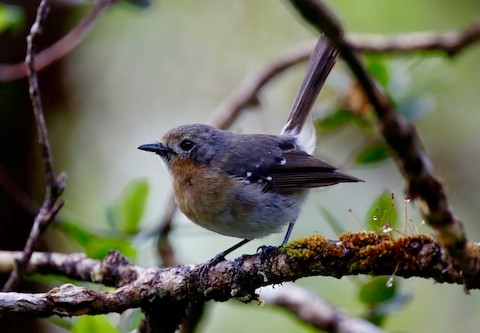
Kauai Elepaio along the Pihea Trail. © Timo Mitzen
Until the 2010s the Akeke’e was regular along the upper portion of Pihea Trail (especially along Pihea Ridge), and in prior decades the Akikiki could often be found with a reasonable confluence of effort and luck (especially on the downslope toward the Alakai Swamp). As of 2020, however, the Akikiki is highly unlikely here and the Akeke’e is infrequent and unpredictable.
Weather permitting, most visitors will opt to turn onto the Alakai Swamp Trail, which skirts just inside the lower boundary of the Alakai Wilderness and after two miles terminates at the spectacular Kilohana Overlook. This hike provides a small chance of finding either of the super-rarities, Puaiohi and Akikiki.
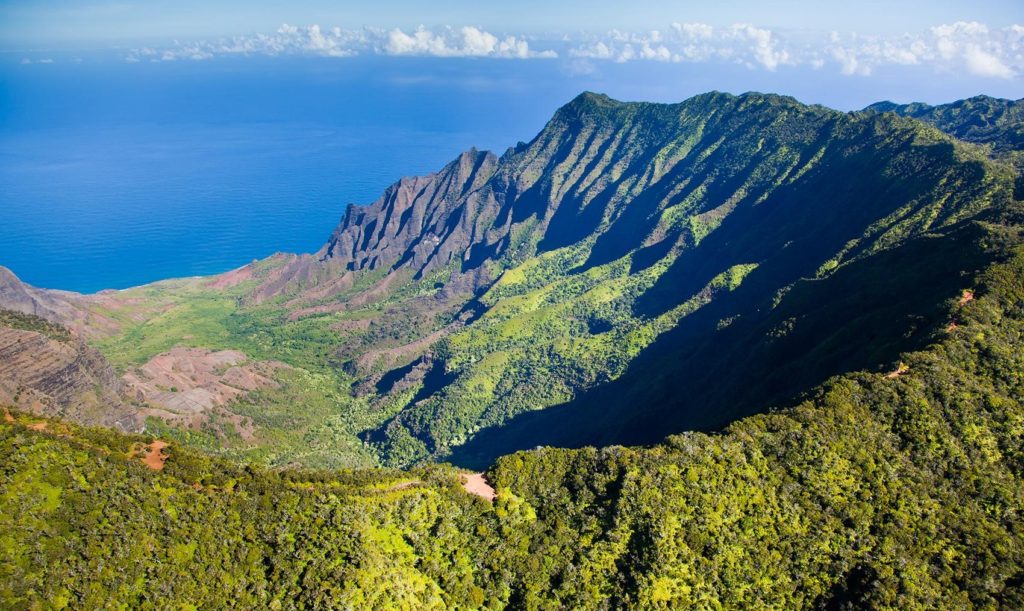
Koke’e State Park: Pihea Ridge and Kalalau Valley. © Go Hawaii
Camp 10 Road. Apart from the main road, Highway 550, the other major access route to Koke’e State Park and its interior trails is Camp 10 Road. Its junction with the main road is across from the campground, about 0.4 miles past the headquarters.
The first mile or so of Camp 10 Road is drivable in a passenger car, but beyond that it becomes risky and unwise. However, parking at this point should make it possible to reach most of the trail system on foot.
Pu’u Ka Ohelo Trail. About 0.7 miles from the main road is a fork. The left branch passes some of the “Cabins at Koke’e” and quickly arrives at the parking spot for the Pu’u Ka Ohelo Trail. This trail forms a mile-long loop back to Camp 10 Road via the Berry Flat Trail.

Male Akeke’e at the junction of the Pihea and Alakai Swamp Trails. © Jen Sanford
Forking right past the Pu’u Ka Ohelo turnoff, you immediately reach a bridge, then a fairly steep uphill climb that can be challenging for passenger cars when muddy. Under these conditions, it is best to park near the bridge and continue down Camp 10 Road on foot. However, if you can drive up the hill, the road flattens out for more than a half-mile, so may be worth an attempt to press a little farther before parking.
Berry Flat Trail. Continuing on Camp 10 Road about 0.5 miles past the Pu’u Ka Ohelo Trail, you will reach the Berry Flat trailhead. Or if you walked the Pu’u Ka Ohelo Trail, a mile’s walk will bring you to this trailhead.
Just past Berry Flat, the road begins a sharp descent, which marks the end of reasonably passable road conditions. There is a wide area in the road with space to park, and most visitors are advised to do so and continue on foot—unless you have a high-clearance four-wheel-drive vehicle.

The Akikiki was formerly fairly common in Koke’e State Park, but is increasingly limited to the inaccessible interior of the Alaka’i Wilderness Preserve. © Bret Mossman
Lower Alakai Swamp Trail. About 1.5 miles past Berry Flat is the Alakai picnic area, where a short side-road leads to the trailhead for the Alakai Swamp Trail. This is the origin of the trail to the Kilohana Overlook, which can also be reached from the upper end of the Pihea Trail (which starts at Pu’u O Kilo Overlook, as discussed above).
The Alakai picnic area marks the boundary between Koke’e State Park and the Na Pali-Kona Forest Reserve.
Lower Pihea Trail. About 0.8 miles past the Alakai picnic area, Kawaikoi Stream crosses Camp 10 Road. When the stream is running high, this is effectively the end of the road for most visitors, as the water may be unsafe or too uncomfortable to wade across. On the near side of the stream is Kawaikoi Campground and the lower trailhead for the Pihea Trail—it is about a four-mile hike from here to the Pu’u O Kilo Overlook.
Kawaikoi Trail. On the farther side of the stream is the Sugi Grove picnic area and the Kawaikoi Trailhead. This trail is especially noted for its scenic beauty and for a strong record of producing Akikiki—although those days may be past.
Mohihi-Waiale Trail. Continue 2.5 miles past the Kawaikoi Stream crossing to reach Camp 10, the end of the road and the gateway to the Alakai Wilderness, via the Mohihi-Waiale Trail.
Services
Accommodations
Cabins at Kokee, 1-808-652-6852: the concessionaire West Kauai Lodging maintains five cabins in the park, available at reasonable prices—but usually require booking many months in advance. Note that the check-in desk is not in the park; the office is in Waimea at 9600 Kaumuali`i Highway.
Koke’e State Park Campground: the park campground is flat, spacious, well-maintained, and generally a good option for anyone with a tent and sleeping bags. The fee for a camping permit is $20 for Hawaii residents, $30 for non-residents (as of December 2020).
Food
Kokee Lodge, 1-808-335-6061, beside the park headquarters, has a bar and restaurant that open every day of the year—but traditionally for limited hours, 9:00 – 3:30.
Notes
Hazards & Hassles
Koke’e State Park is a challenging area to explore, mainly due to weather and the condition of the roads and trails.
The highlands of northwestern Kauai receive about as much annual precipitation as any other place on the planet—in fact, Mount Wai’ale’ale, at the upper end of the Alakai Wilderness, was long regarded as the wettest place on Earth (but has been demoted to second-wettest since being usurped by the rain gauge at Mawsynram in India). Many parts of the Koke’e region are perpetually muddy, and on some trails into the Alakai Swamp the mud is generally advertised as being waist-deep.
It rains most days and is cloudy most of the time. Evenings and mornings are cold, but midday can be hot—and is almost always humid. It is difficult to dress comfortably for these conditions, especially accounting for the exertion of trail exploration.
Camp 10 Road is treacherous and should be driven only to one of the natural stopping points near the Pu’u Ka Ohelo and Berry Flat Trails—except by experienced drivers with vehicles that are suitably rugged for the conditions that prevail beyond Berry Flat, as verified at the time of the visit.
Links